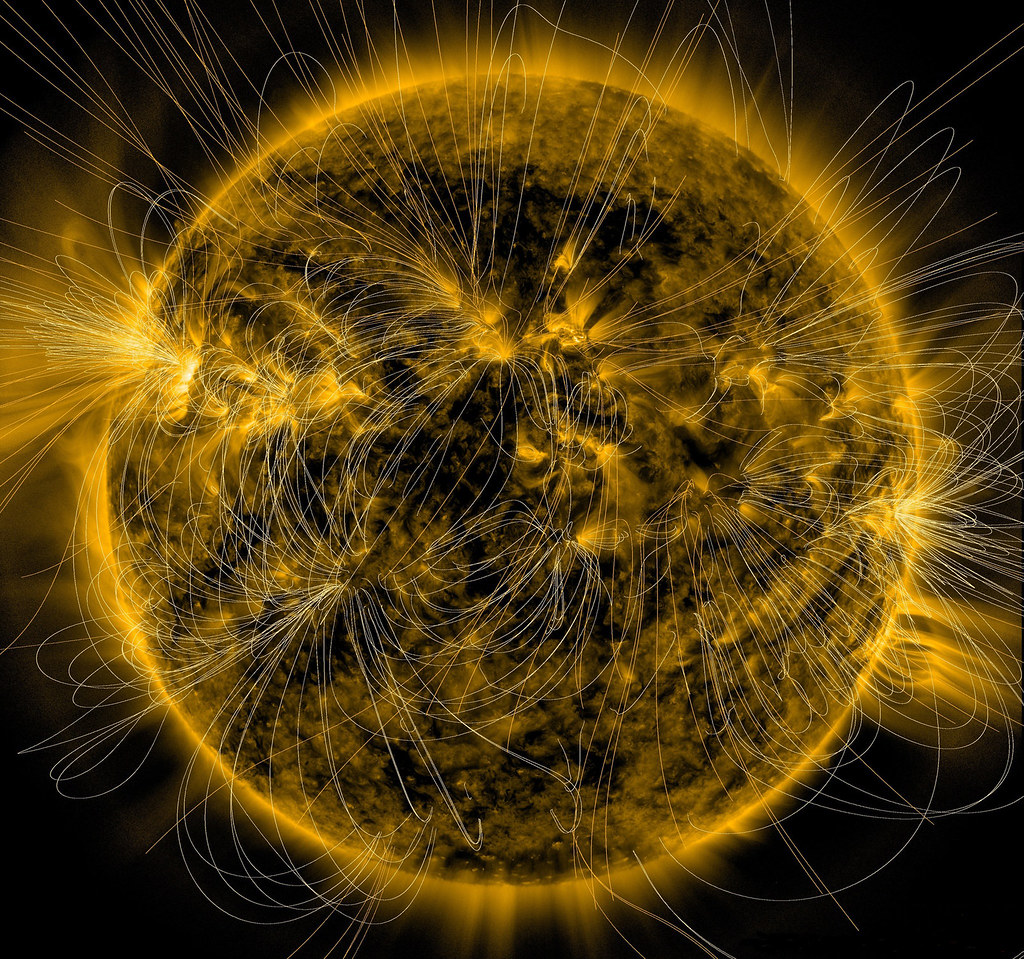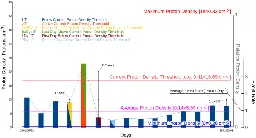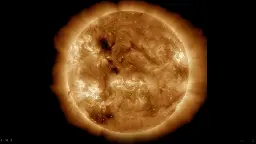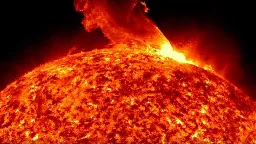
- www.nature.com On the correlation between solar activity and large earthquakes worldwide - Scientific Reports
Large earthquakes occurring worldwide have long been recognized to be non Poisson distributed, so involving some large scale correlation mechanism, which could be internal or external to the Earth. Till now, no statistically significant correlation of the global seismicity with one of the possible m...

Abstract: Large earthquakes occurring worldwide have long been recognized to be non Poisson distributed, so involving some large scale correlation mechanism, which could be internal or external to the Earth. Till now, no statistically significant correlation of the global seismicity with one of the possible mechanisms has been demonstrated yet. In this paper, we analyze 20 years of proton density and velocity data, as recorded by the SOHO satellite, and the worldwide seismicity in the corresponding period, as reported by the ISC-GEM catalogue. We found clear correlation between proton density and the occurrence of large earthquakes (M > 5.6), with a time shift of one day. The significance of such correlation is very high, with probability to be wrong lower than 10–5. The correlation increases with the magnitude threshold of the seismic catalogue. A tentative model explaining such a correlation is also proposed, in terms of the reverse piezoelectric effect induced by the applied electric field related to the proton density. This result opens new perspectives in seismological interpretations, as well as in earthquake forecast.
-
The Automatic Identification and Tracking of Coronal Flux Ropes -- Part I: Footpoints and Fluxes
Abstract: Investigating the early-stage evolution of an erupting flux rope from the Sun is important to understand the mechanisms of how it looses its stability and its space weather impacts. Our aim is to develop an efficient scheme for tracking the early dynamics of erupting solar flux ropes and use the algorithm to analyse its early-stage properties. The algorithm is tested on a data-driven simulation of an eruption that took place in active region AR12473. We investigate the modelled flux rope's footpoint movement and magnetic flux evolution and compare with observational data from the Solar Dynamics Observatory's Atmospheric Imaging Assembly in the 211 Å and 1600 Å channels. To carry out our analysis, we use the time-dependent data-driven magnetofrictional model (TMFM). We also perform another modelling run, where we stop the driving of the TMFM midway through the flux rope's rise through the simulation domain and evolve it instead with a zero-beta magnetohydrodynamic (MHD) approach. The developed algorithm successfully extracts a flux rope and its ascend through the simulation domain. We find that the movement of the modelled flux rope footpoints showcases similar trends in both TMFM and relaxation MHD run: they recede from their respective central location as the eruption progresses and the positive polarity footpoint region exhibits a more dynamic behaviour. The ultraviolet brightenings and extreme ultraviolet dimmings agree well with the models in terms of their dynamics. According to our modelling results, the toroidal magnetic flux in the flux rope first rises and then decreases. In our observational analysis, we capture the descending phase of toroidal flux. In conclusion, the extraction algorithm enables us to effectively study the flux rope's early dynamics and derive some of its key properties such as footpoint movement and toroidal magnetic flux.
-
Magnetohydrodynamic Mode Conversion in the Solar Corona Insights from Fresnel-like Models of Waves at Sharp Interfaces
Abstract: The solar atmosphere is known to contain many different types of wavelike oscillation. Waves and other fluctuations (e.g., turbulent eddies) are believed to be responsible for at least some of the energy transport and dissipation that heats the corona and accelerates the solar wind. Thus, it is important to understand the behavior of magnetohydrodynamic (MHD) waves as they propagate and evolve in different regions of the Sun’s atmosphere. In this paper, we investigate how MHD waves can affect the overall plasma state when they reflect and refract at sharp, planar interfaces in density. First, we correct an error in a foundational paper (Stein 1971) that affects the calculation of wave energy-flux conservation. Second, we apply this model to reflection-driven MHD turbulence in the solar wind, where the presence of density fluctuations can enhance the generation of inward-propagating Alfven waves. This model reproduces the time-averaged Elsasser imbalance fraction (i.e., ratio of inward to outward Alfvenic power) from several published numerical simulations. Lastly, we model how the complex magnetic field threading the transition region between the chromosphere and corona helps convert a fraction of upward-propagating Alfven waves into fast-mode and slow-mode MHD waves. These magnetosonic waves dissipate in a narrow region around the transition region and produce a sharp peak in the heating rate. This newly found source of heating sometimes exceeds the expected heating rate from Alfvenic turbulence by an order of magnitude. It may explain why some earlier models seemed to require an additional ad-hoc heat source at this location.
-
A fundamental mechanism of solar eruption initiation in multipolar magnetic field
Abstract: Recently we established a fundamental mechanism of solar eruption initiation, in which an eruption can be initiated from a bipolar field through magnetic reconnection in the current sheet (CS) that is formed slowly in the core field as driven by photospheric shearing motion. Here using a series of fully 3D MHD simulations with a range of different photospheric magnetic flux distributions, we extended this fundamental mechanism to the quadrupolar magnetic field containing a null point above the core field, which is the basic configuration of the classical breakout model. As is commonly believed, in such multipolar configuration, the reconnection triggered in the CS originated at the null point (namely, the breakout reconnection) plays the key role in eruption initiation by establishing a positive feedback-loop between the breakout reconnection and the expansion of the core field. However, our simulation showed that the key of eruption initiation in such multipolar configuration remains to be the slow formation of the CS in the sheared core rather than the onset of fast breakout reconnection. The breakout reconnection only helps the formation of the core CS by letting the core field expand faster, but the eruption cannot occur when the bottom surface driving is stopped well before the core CS is formed, even though the fast reconnection has already been triggered in the breakout CS. This study clarified the role of breakout reconnection and confirmed formation of the core CS as the key to the eruption initiation in a multipolar magnetic field.
-
Discovery of a relation between the decay rate of the Sun's magnetic dipole and the growth rate of the following sunspot cycle: a new precursor for solar cycle prediction
Abstract: Sunspots have been observed for over four centuries and the magnetic nature of sunspot cycles has been known for about a century: however, some of its underlying physics still remain elusive. It is known that the solar magnetic cycle involves a recycling of magnetic flux between the poloidal and toroidal components of the magnetic field, that manifests as the solar dipole and sunspots, respectively. Here we report the discovery of a new relationship between the rise rate of the sunspot cycle and the decay rate of the solar (axial) dipole moment. We argue that this points to the existence of a causal connection between the aforementioned physical quantities -- providing an extension to the Waldmeier effect: namely, the decay rate of the Sun's dipole moment is related to the rate of rise and eventual amplitude of the following sunspot cycle. We demonstrate how one may take advantage of this new relationship to predict the amplitude and timing of the sunspot cycle. Our analysis indicates solar cycle 25 is going to be a weak-moderate cycle, peaking in \(2024.00_{-0.49}^{+0.68} \).
- www.yahoo.com Sun breaks out with record number of sunspots, sparking solar storm concerns
The sun has produced 163 sunspots in June, the highest monthly number in more than two decades, sparking concerns that Earth may soon face space weather trouble.

- in.mashable.com Breakthrough Discovery Of Sun Emitting Highest-Energy Radiation Shakes Up Solar Physics
Turns out the Sun had some surprises in store for us!
